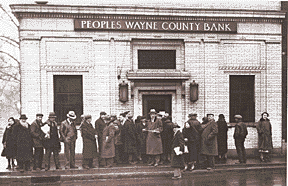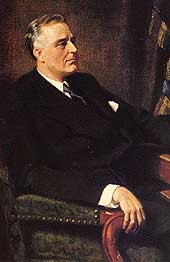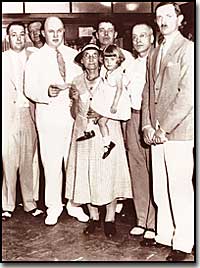49a. A Bank Holiday

Before the Banking Reform Act of 1933, keeping your money in a bank was not a sure way to save. If the bank made unwise investments, the bank could fail and depositors' money would be lost. Here, depositors line up outside a Detroit bank hoping to get their savings back.
In days past, depositing money in a savings account carried a degree of risk. If a bank made bad investments and was forced to close, individuals who did not withdraw their money fast enough found themselves out of luck. Sometimes a simple rumor could force a bank to close. When depositors feared a bank was unsound and began removing their funds, the news would often spread to other customers. This often caused a panic, leading people to leave their homes and workplaces to get their money before it was too late.
These runs on banks were widespread during the early days of the Great Depression. In 1929 alone, 659 banks closed their doors. By 1932, an additional 5102 banks went out of business. Families lost their life savings overnight. Thirty-eight states had adopted restrictions on withdrawals in an effort to forestall the panic. Bank failures increased in 1933, and Franklin Roosevelt deemed remedying these failing financial institutions his first priority after being inaugurated.

With quick and effective legislation, Franklin Delano Roosevelt, 32nd President of the United States, was able to halt the bank crisis.
Roosevelt, unlike Hoover, was quick to act. Two days after taking the oath of office, Roosevelt declared a "bank holiday." From March 6 to March 10, banking transactions were suspended across the nation except for making change. During this period, Roosevelt presented the new Congress with the Emergency Banking Act. The law empowered the President through the Treasury Department to reopen banks that were solvent and assist those that were not. The House allowed only forty minutes of debate before passing the law unanimously, and the Senate soon followed with overwhelming support.
Banks were divided into four categories. Surprisingly, slightly over half the nation's banks were deemed first category and fit to reopen. The second category of banks was permitted to allow a percentage of its deposits to be withdrawn. The third category consisted of banks that were on the brink of collapse. When the holiday was ended, these banks were only permitted to accept deposits. Five percent of banks were in the final category — unfit to continue business.
On the Sunday evening before the banks reopened, Roosevelt addressed the nation through one of his signature "fireside chats." With honest words in soothing tones, the President assured sixty million radio listeners that the crisis was over and the nation's banks were secure. On the first day back in business, deposits exceeded withdrawals. By the beginning of April, Americans confidently returned a billion dollars to the banking system. The bank crisis was over.

Ms. Lydia Lobsiger became the first American citizen to be paid by the Federal Deposit Insurance Corporation for deposits in an insured bank that failed.
But the legislation was not. On June 16, 1933, Roosevelt signed the Glass-Steagall Banking Reform Act. This law created the Federal Deposit Insurance Corporation. Under this new system, depositors in member banks were given the security of knowing that if their bank were to collapse, the federal government would refund their losses. Deposits up to $2500, a figure that would rise through the years, were henceforth 100% safe. The act also restricted banks from recklessly speculating depositors' money in the stock market. In 1934, only 61 banks failed .
Letters poured in to the White House from grateful Americans. Workers and farmers were thrilled that their savings were indeed now safe. Bankers breathed a sigh of relief knowing that Roosevelt did not intend to nationalize the banking system as many European countries had already done. Although radical in speed and scope, Roosevelt's banking plan strengthened the current system, without fundamentally altering it. One of his advisors quipped, "Capitalism was saved in eight days."






